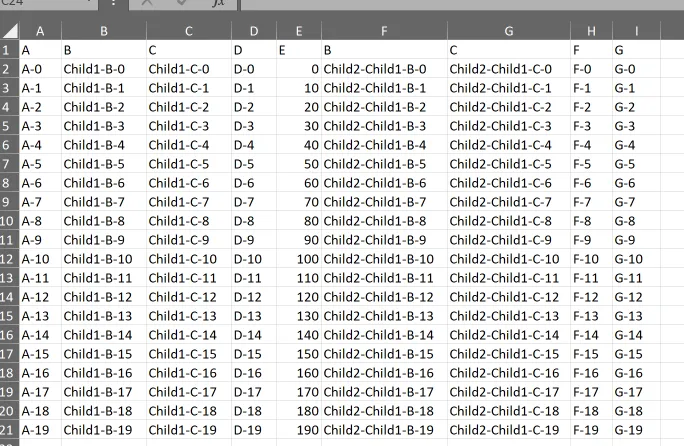没有本地函数可以做到这一点。很难想出一个通用的解决方案,因为它需要做出很多假设。哪些属性类型应该自动导出,哪些应该被视为子节点并具有其属性导出或展开。但是,如果你能想到这一点,那么从那里开始就是基本的树遍历。
下面是我从类似任务中改编的代码。在这里,我假设任何既是字符串又是没有属性的数据类型都被认为是导出的值类型(例如int、double等)。但是很容易根据需要进行调整。我匆忙拼凑了这个代码,可能还没有完全优化:
public static void ExportFlatExcel<T>(IEnumerable<T> dataCollection, FileInfo file, string worksheetName)
{
using (var package = new ExcelPackage(file))
{
var worksheet =
package.Workbook.Worksheets.FirstOrDefault(excelWorksheet => excelWorksheet.Name == worksheetName) ??
package.Workbook.Worksheets.Add(worksheetName);
const BindingFlags flags = BindingFlags.Instance | BindingFlags.Public;
var props = typeof (T).GetProperties(flags);
var rootTree = new Branch<PropertyInfo>(null);
var stack = new Stack<KeyValuePair<PropertyInfo, IBranch<PropertyInfo>>>(
props
.Reverse()
.Select(pi =>
new KeyValuePair<PropertyInfo, IBranch<PropertyInfo>>(
pi
, rootTree
)
)
);
while (stack.Any())
{
var node = stack.Pop();
var prop = node.Key;
var branch = node.Value;
if (prop.PropertyType == typeof (string))
{
branch.AddNode(new Leaf<PropertyInfo>(prop));
continue;
}
var childProps = prop.PropertyType.GetProperties(flags);
if (!childProps.Any())
{
branch.AddNode(new Leaf<PropertyInfo>(prop));
continue;
}
var child = new Branch<PropertyInfo>(prop);
branch.AddNode(child);
childProps
.Reverse()
.ToList()
.ForEach(pi => stack
.Push(new KeyValuePair<PropertyInfo, IBranch<PropertyInfo>>(
pi
, child
)
)
);
}
var rows = dataCollection.ToList();
for (var r = 0; r < rows.Count; r++)
{
var currRow = rows[r];
var col = 0;
foreach (var child in rootTree.Children)
{
var nodestack = new Stack<Tuple<INode, object>>();
nodestack.Push(new Tuple<INode, object>(child, currRow));
while (nodestack.Any())
{
var tuple = nodestack.Pop();
var node = tuple.Item1;
var currobj = tuple.Item2;
var branch = node as IBranch<PropertyInfo>;
if (branch != null)
{
currobj = branch.Data.GetValue(currobj, null);
branch
.Children
.Reverse()
.ToList()
.ForEach(cnode => nodestack.Push(
new Tuple<INode, object>(cnode, currobj)
));
continue;
}
var leaf = node as ILeaf<PropertyInfo>;
if (leaf == null)
continue;
worksheet.Cells[r + 2, ++col].Value = leaf.Data.GetValue(currobj, null);
if (r == 0)
worksheet.Cells[r + 1, col].Value = leaf.Data.Name;
}
}
}
package.Save();
package.Dispose();
}
}
假设你有这样一个结构:
#region Classes
public class Parent
{
public string A { get; set; }
public Child1 Child1 { get; set; }
public string D { get; set; }
public int E { get; set; }
public Child2 Child2 { get; set; }
}
public class Child1
{
public string B { get; set; }
public string C { get; set; }
}
public class Child2
{
public Child1 Child1 { get; set; }
public string F { get; set; }
public string G { get; set; }
}
#endregion
#region Tree Nodes
public interface INode { }
public interface ILeaf<T> : INode
{
T Data { get; set; }
}
public interface IBranch<T> : ILeaf<T>
{
IList<INode> Children { get; }
void AddNode(INode node);
}
public class Leaf<T> : ILeaf<T>
{
public Leaf() { }
public Leaf(T data) { Data = data; }
public T Data { get; set; }
}
public class Branch<T> : IBranch<T>
{
public Branch(T data) { Data = data; }
public T Data { get; set; }
public IList<INode> Children { get; } = new List<INode>();
public void AddNode(INode node)
{
Children.Add(node);
}
}
#endregion
我将作为一个测试来翻译这个内容:
[TestMethod]
public void ExportFlatTest()
{
var list = new List<Parent>();
for (var i = 0; i < 20; i++)
list.Add(new Parent
{
A = $"A-{i}",
D = $"D-{i}",
E = i*10,
Child1 = new Child1
{
B = $"Child1-B-{i}",
C = $"Child1-C-{i}",
},
Child2 = new Child2
{
F = $"F-{i}",
G = $"G-{i}",
Child1 = new Child1
{
B = $"Child2-Child1-B-{i}",
C = $"Child2-Child1-C-{i}",
}
}
});
var file = new FileInfo(@"c:\temp\flat.xlsx");
if (file.Exists)
file.Delete();
TestExtensions.ExportFlatExcel(
list
, file
, "Test1"
);
}
我会给你这个:
将会给你这个:

